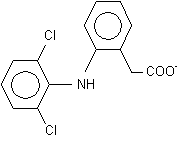METHOD OF PREPARATION
1. Calculate the required quantity of each ingredient for the total amount to be prepared.
2. Accurately weigh and/or measure each ingredient.
3. Mix the diclofenac sodium and the carbomer 940 with the propylene glycol.
4. Add the alcohol and mix well.
5. Add purified water to a volume of about 95 mL and mix well.
6. Add sufficient trolamine until the desired viscosity is obtained or a pH of about 6.
7. Add sufficient purified water to volume and mix well.
8. Package and label.
PACKAGING
Package in tight, light-resistant containers.1
LABELING
Keep out of reach of children. Use only as directed.
STABILITY
A beyond-use date of up to 30 days would be appropriate for this preparation.1
USE
Diclofenac sodium topical gel has been used in the treatment of sunburn.
QUALITY CONTROL
Quality-control assessment can include theoretical weight compared to actual weight, pH, specific gravity, active drug assay, color, clarity, texture-surface, texture-spatula spread, appearance, feel, rheological properties and physical observations.
DISCUSSION
The painful period during the first couple of days after experiencing a sunburn can be relieved using topical nonsteroidal anti-inflammatory drugs such as ibuprofen and diclofenac. The concentration of this gel can be easily modified. The alcohol allows it to be applied and evaporate rapidly. If desired, a few drops of simethicone can be added to minimize the tacky feeling experienced by some when carbomers are used.
Diclofenac sodium (C^sub 14^H^sub 10^Cl^sub 2^NNaO^sub 2^, MW 318.13) is a phenylacetic acid derivative that is a nonsteroidal anti-inflammatory agent with antipyretic activity. It is used in the treatment of inflammatory diseases (ie, rheumatoid arthritis, osteoarthritis, ankylosing spondylitis, juvenile arthritis) and dysmenorrhea and for its antipyretic effect. It is used topically in the treatment of actinic keratoses as a 3% gel and has been used in the treatment of sunburn. It occurs as a white to off-white, hygroscopic, crystalline powder. It is soluble in ethanol and sparingly soluble in water.1,3
Propylene glycol (C^sub 3^H^sub 8^O^sub 2^, MW 76.09) occurs as a clear, colorless, viscous, practically odorless liquid with a sweet taste, somewhat resembling glycerin. It is miscible with acetone, 95% ethanol, glycerin and water.4
Carbomer 940 is a synthetic, high-molecular-weight polymer. Carbomers are composed of acrylic acid cross-linked with either allyl sucrose or allyl ethers of pentaerythritol and occur as white-colored, fluffy, acidic, hygroscopic powders with a slight characteristic odor. The molecular weight of carbomer 940 is approximately 4 × 10^sup 6^. It is soluble in water and, after neutralization, in 95% ethanol and glycerin. When carbomers are dispersed in water, an acidic colloidal solution of low viscosity will form that will thicken when an alkaline material, such as triethanolamine, is added.5
Alcohol (C^sub 2^H^sub 5^OH, MW 46.07, ethyl alcohol, ethanol, grain alcohol) is a clear, colorless mobile and volatile liquid with a slight, characteristic odor and a burning taste. It is miscible with glycerin and water.6
Trolamine (C^sub 6^H^sub 15^NO^sub 3^, MW 149.19, TEA, triethanolamine) is an alkalizing and emulsifying agent. It occurs as a variable mixture of alkanolamines and is a clear, colorless to pale yellow-colored, viscous liquid with a slight ammoniacal odor. Its specific gravity is about 1.120-1.128 g/mL and it has a pH of 10.5 in a 0.1N aqueous solution. It is very hygroscopic, melts at 20°C to 21°C and boils at 335°C. It is miscible with water, 95% ethanol, methanol and acetone.7
REFERENCES
1. US Pharmacopeial Convention, Inc. United States Pharmacopeia 27-National Formulary 22. Rockville, MD: US Pharmacopeial Convention, Inc.; 2004: 595-596, 2345-2349, 2759.
2. Allen LV Jr. Standard operating procedure for performing physical quality assessment of ointments/creams/gels. IJPC 1998; 2: 308-309.
3. McEvoy GK. AHFS Drug Information-2004. Bethesda, MD: American Society of Health-System Pharmacists; 2004: 1059-1965, 3434-3435.
4. Weller PJ. Propylene glycol. In: Rowe RC, Sheskey PJ, Weller PJ, eds. Handbook of Pharmaceutical Excipients. 4th ed. Washington, DC: American Pharmaceutical Association; 2003: 521-523.
5. Koleng JJ, McGinity JW, Wilber WR. Carbomer. In: Rowe RC, Sheskey PJ, Weller PJ, eds. Handbook of Pharmaceutical Excipients. 4th ed. Washington, DC: American Pharmaceutical Association; 2003: 89-92.
6. Owen SC. Alcohol. In: Rowe RC, Sheskey PJ, Weller PJ, eds. Handbook of Pharmaceutical Excipients. 4th ed. Washington, DC: American Pharmaceutical Association; 2003: 13-15.
7. Goskonda SR, Lee JC. Triethanolamine. In: Rowe RC, Sheskey PJ, Weller PJ, eds. Handbook of Pharmaceutical Excipients. 4th ed. Washington, DC: American Pharmaceutical Association; 2003: 663-664.
Copyright International Journal of Pharmaceutical Compounding Sep/Oct 2004
Provided by ProQuest Information and Learning Company. All rights Reserved



